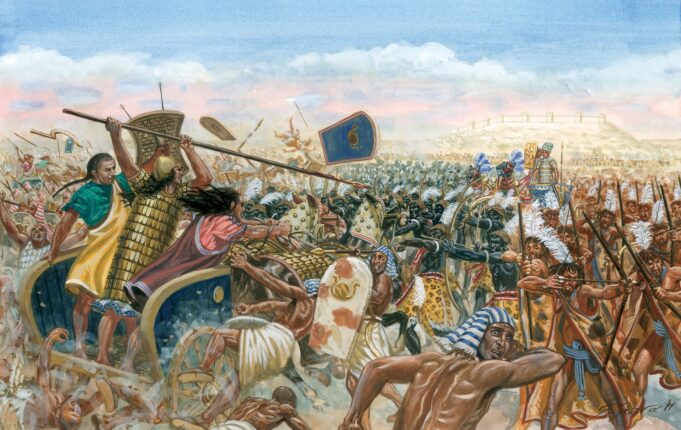The Battle of Kadesh, fought around 1274 BCE between the forces of the Egyptian Empire and the Hittite Kingdom, is one of the most famous military confrontations of the ancient world. This monumental clash, often referred to as the “First Great Chariot War,” marked the first significant large-scale battle to be fought primarily with chariots. The confrontation not only played a key role in shaping the ancient Middle Eastern political landscape but also led to one of the earliest recorded peace treaties in history.
In this article, we’ll delve into the significance of the Battle of Kadesh, exploring the key players, strategies, and its long-lasting impact on both Egypt and the Hittite Empire.
Yuk main sekarang di slot depo 5k cukup modal kecil sudah bisa meraih jackpot besar!
The Context Of The Battle of Kadesh: Rising Empires and Rivalries
The Egyptian Empire, under Pharaoh Ramesses II, and the Hittite Empire, led by King Muwatalli II, were two dominant forces in the ancient world. Both empires were vying for control over key territories in the Near East, including the region around Kadesh, a strategically important city located in modern-day Syria.
At the time, the Egyptian Empire was at its height, and Ramesses II, also known as Ramesses the Great, had firmly established his rule across vast stretches of Africa and the Levant. Meanwhile, the Hittites were expanding their influence across Anatolia and northern Syria, placing them in direct conflict with Egypt.
The Battle of Kadesh occurred as a result of both empires seeking dominance in the region. With Kadesh lying on the Orontes River, it controlled the trade routes between Mesopotamia and the Mediterranean, making it a critical point of contention. Both empires sought to control it, setting the stage for one of the most famous battles of antiquity.
The Armies: Chariots and Strategy
The Battle of Kadesh is notable not only for its historical importance but also for the way it was fought. It marked the first large-scale use of chariots in warfare, a tactic that would dominate ancient combat for centuries. The Egyptian and Hittite armies were both heavily reliant on chariots, which were used for their speed and shock value on the battlefield.
Ramesses II’s army, consisting of around 20,000 men, was made up of infantry, archers, and chariots. The chariots, driven by two-man teams, were used for rapid maneuvers and devastating strikes against enemy formations. Ramesses led a portion of his forces in a direct assault on the city of Kadesh, with the goal of capturing it quickly.
The Hittites, on the other hand, had an army that was equally formidable. King Muwatalli II commanded a large force, estimated to be around 30,000 strong, including a considerable number of chariots. The Hittite strategy was more defensive at first, relying on ambush tactics and carefully timed attacks. Muwatalli positioned his troops in a way that would give them the element of surprise when Ramesses’ forces approached.
The Battle: Ambush and Chaos
The Battle of Kadesh unfolded in a dramatic and chaotic manner. As the Egyptian forces moved toward the city, they were caught off guard by a Hittite ambush. The Hittites, knowing the terrain better, launched their chariots from behind the cover of the city walls, trapping the Egyptian forces in a pincer movement.
Ramesses, who initially believed his army was in a favorable position, found himself surrounded by the Hittite forces. In a moment of desperation, he reportedly urged his men to fight fiercely, leading a bold counterattack. His chariot was said to have been a rallying point, where he personally led his soldiers into battle, despite being outnumbered.
For hours, the two armies clashed fiercely, with chariots darting across the battlefield. The Egyptian infantry struggled to maintain their positions against the Hittite chariots, which proved to be a decisive force. However, the arrival of reinforcements for the Egyptians, combined with Ramesses’ personal leadership, helped to stave off complete defeat.
The Outcome: A Stalemate and Treaty
Although the battle ended without a clear victor, the Egyptians claimed a tactical victory. Ramesses II, in his inscriptions, proclaimed that he had successfully defeated the Hittites and had forced them to retreat. However, many historians believe that the battle was a stalemate, with both sides suffering heavy casualties and neither gaining a clear advantage.
The aftermath of the Battle of Kadesh, however, was crucial in shaping the future of both empires. Recognizing the futility of continuing a costly war, both Ramesses II and Muwatalli II agreed to negotiate peace. This led to the signing of one of the earliest recorded peace treaties in history, the Treaty of Kadesh, which was engraved on two tablets and later found in both Egyptian and Hittite versions.
The treaty established mutual respect for each other’s borders and was one of the first instances in history where two great empires reached a diplomatic resolution to their conflict. The treaty also established a diplomatic relationship that lasted for many years, marking a significant shift from warfare to diplomacy in international relations.
The Legacy of the Battle of Kadesh
The Battle of Kadesh remains one of the most significant military confrontations of the ancient world, not only because of the scale of the battle and the innovative use of chariots but also because of its lasting impact on Egyptian-Hittite relations.
The treaty that followed the battle is often regarded as a milestone in the history of diplomacy, demonstrating the power of negotiation over endless conflict. The Battle of Kadesh also set a precedent for future military campaigns, particularly in terms of the use of chariots, which became a staple in warfare across the ancient world.
Moreover, Ramesses II’s portrayal of the battle as a great Egyptian victory helped to bolster his image as a mighty ruler and warrior, contributing to his legacy as one of Egypt’s most famous pharaohs. The battle, while not a decisive military triumph, certainly contributed to his reputation as a powerful and strategic leader.
Conclusion
The Battle of Kadesh stands as a monumental chapter in ancient history, where military strategy, chariot warfare, and diplomacy intertwined to shape the future of the ancient Near East. Though it did not result in a clear victor, its aftermath reshaped the relationships between Egypt and the Hittites, laying the groundwork for one of the earliest peace agreements in recorded history.
The legacy of the Battle of Kadesh endures not only in the annals of military history but also in the evolution of diplomacy and international relations. As we reflect on this significant event, we are reminded of the importance of strategy, negotiation, and the role of leadership in times of conflict.




